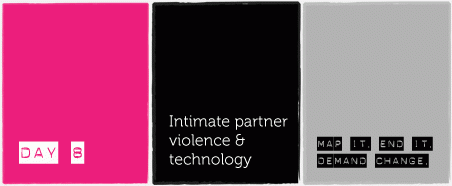
There is nothing domestic or tame about domestic violence and intimate partner abuse! A woman (it is overwhelmingly women) caught in an abusive and violent intimate relationship has her sense of self, her dignity and integrity violated. It does harm to her health, her ability to function in the workplace and society, and to her body and safety.
Domestic violence or intimate partner violence is an abuse of power in an intimate or familial relationship. It involves one spouse or partner controlling and dominating the other through physical, sexual, emotional and/or psychological violence, or through control of her finances, mobility and social life. This type of violence knows no class, race, geography or sexual orientation. It means that the place where we should be safe and secure is a place of fear.
In the digital environment, women in abusive relationships can be particularly vulnerable. Sharing a home space means that abusers will usually have easier access to the technology used by the survivor, such as mobile phones or internet search histories. Abusers may use a variety of tools and strategies to track and monitor survivors' activities and movements. The widespread use of mobile phones and global positioning systems (GPS) means that monitoring and tracking activities, contacts and movement are made easier. Reading through internet search histories, or SMS messages are common ways for abusers to trace survivors attempts to leave and to deepen their control. Some women are also pressured by their partners to allow sexualised videos or photographs of them to be taken - and the pictures are then used to blackmail the women into staying with an abusive partner.
At the same time, information and communication technologies are also used by survivors to connect for support, information and help. Women living in situations of intimate partner violence have used the internet to overcome isolation, access information for legal protection, health issues and available services and to find online support groups. These spaces have the potential to be the connectors and informers that are not available to survivors offline. Documenting evidence of abuse using mobile phone by taking photographs or audio recordings, sending an SMS for help are some strategies for survivors.
There is still a lot of silence surrounding domestic and intimate partner violence. Because the abuser is someone close, with complications of financial and emotional dependency, and because the family is where you're safe, and because often, society condones it, domestic violence is believed to be one of the most under-reported crimes.
Silence and isolation helps to keep the abuser in control. Break the silence. Take control of technology and make the violence known. Claim your power and map it!
1) SHARE YOUR STORY
- If you have experienced intimate partner violence and your abuser is using ICTs to control, monitor, threaten or harm you, add your story to the map.
- Click on “Submit a report”.
- Write a description of the space and why you think it supports a culture of VAW online.
- Tick “Intimate partner violence” under the “Type of VAW” category, and tick other options where applicable.
- Mark on the map the region the site is focussing on, or if it is global, the town/city where you are (do not write your home address or street address, just a broad area or landmark will do).
- When you have submitted your story, don't forget to delete your internet history and clear your browser cache if visiting this site puts you are risk.
2) LISTEN
- Listen and read the stories that are mapped.
- Extend your support by leaving a comment, or by sharing your own experience and knowledge.
- If you know of someone who is facing intimate partner violence, tell her about this action, and use it as an opportunity to talk with her about her situation.
- Find out information about women's rights organisations working on violence against women, and explore options with her.
- The most important thing is that she is heard, and that she knows she is not alone.
3) SUPPORT
- Grow the call and spread the word.
- If you’re on Twitter, tweet your thoughts and responses.
- Put up phone numbers of local women's rights organisations that can provide legal and other kinds of support on your status messages, your Facebook page or Twitter posts.
- Gather survivors and/or support organisations who work in preventing domestic violence, and tweet strategies to keep your Tech safe from abusers!
- Grow the call by using the #takebackthetech and #16days hashtag.
Participate and collectively build a loud of body of evidence on the way technology impacts on intimate partner violence. Turn domestic violence a matter of public concern. Make it visible!
- Log in to post comments
